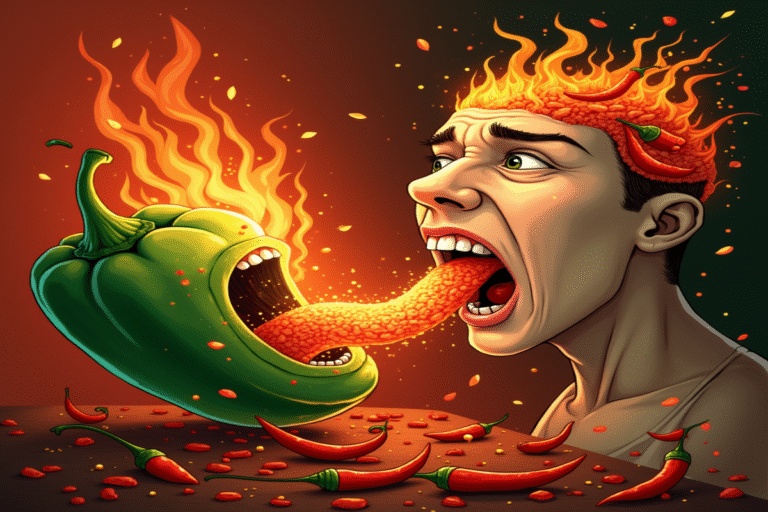Have you ever wondered why biting into a jalapeño sends your taste buds into a fiery frenzy, even though the pepper itself isn’t actually hot to the touch? This burning sensation isn’t your imagination – it’s fascinating chemistry at work inside your mouth!
Meet Capsaicin: The Molecule Behind the Burn
The culprit behind that mouth-scorching feeling is a compound called capsaicin. This colorless, odorless molecule is concentrated mostly in the white pith of chili peppers, not the seeds, and serves as the plant’s natural defense mechanism. While chili peppers evolved for their fruits to be eaten so their seeds can be dispersed, capsaicin deters mammals (like us) from eating them, since mammals typically destroy seeds during digestion.
Interestingly, birds can’t detect capsaicin and don’t experience any burning sensation when eating spicy peppers. This clever evolutionary advantage ensures birds – who don’t damage the seeds when digesting them – become the perfect seed dispersers for chili plants.
Your Brain on Fire: How Capsaicin Tricks Your Nervous System
When you bite into a spicy pepper, capsaicin binds to special receptors called TRPV1 (transient receptor potential vanilloid 1) located on the nerve endings in your mouth and tongue. These receptors normally detect real heat and painful stimuli – they’re the same ones that tell you when you’ve touched something too hot.
Capsaicin essentially “hacks” these receptors, causing them to send the same pain and heat signals to your brain as if you were actually burning your mouth. Your brain can’t tell the difference between capsaicin and real heat, so it responds accordingly: increased blood flow, sweating, and that unmistakable burning sensation.
The Spice Paradox: Why We Love the Pain
If spicy food activates pain receptors, why do so many people around the world love the sensation? The answer lies in your body’s response to the “attack.”
When your brain registers capsaicin-induced pain, it releases endorphins – your body’s natural painkillers that create feelings of pleasure and euphoria. This biochemical response produces a unique experience that many find addictive: pain followed by pleasure. It’s nature’s own thrill ride!
Regular consumption of spicy foods can even lead to desensitization of your TRPV1 receptors, letting spice lovers tolerate hotter foods over time – a phenomenon known as “building spice tolerance.”
Measuring the Burn: The Scoville Scale
How do we measure how spicy different peppers are? In 1912, pharmacist Wilbur Scoville developed the Scoville Heat Unit (SHU) scale to measure capsaicin concentration. The scale ranges from:
- Bell peppers: 0 SHU (no capsaicin)
- Jalapeños: 2,500–8,000 SHU
- Habaneros: 100,000–350,000 SHU
- Carolina Reaper: over 2,200,000 SHU (currently the world’s hottest pepper)
Beyond the Burn: Health Benefits of Spicy Food
Research suggests that capsaicin may offer several health benefits, including:
- Boosting metabolism and potentially aiding weight loss
- Reducing inflammation when used topically
- Supporting cardiovascular health
- Providing antimicrobial effects
Capsaicin is even used in creams to relieve arthritis pain and neuropathy, showing how this “painful” compound can be harnessed for therapy.
Cooling the Flames
When your mouth is on fire from spicy food, drinking water won’t help much. Capsaicin is hydrophobic – it repels water, which just spreads it around your mouth. Instead, try:
- Dairy products: Casein proteins in milk bind to capsaicin and help wash it away
- Fatty foods: Oils can dissolve the fat-soluble capsaicin
- Starchy foods: Rice or bread can physically absorb the compounds
Next time you feel that delicious burn from your favorite spicy dish, you’ll know exactly what’s happening – your brain isn’t actually sensing heat, but rather experiencing a clever chemical trick created by plants to protect their seeds. It’s a perfect example of how evolution, chemistry, and neuroscience come together on your dinner plate!





